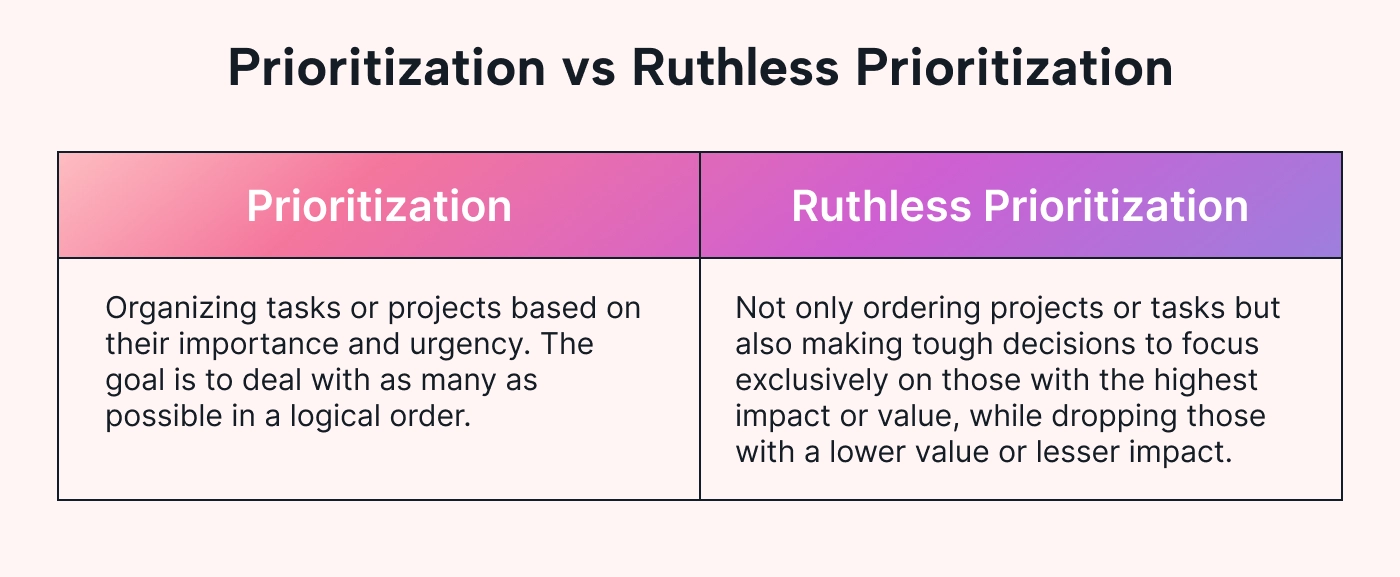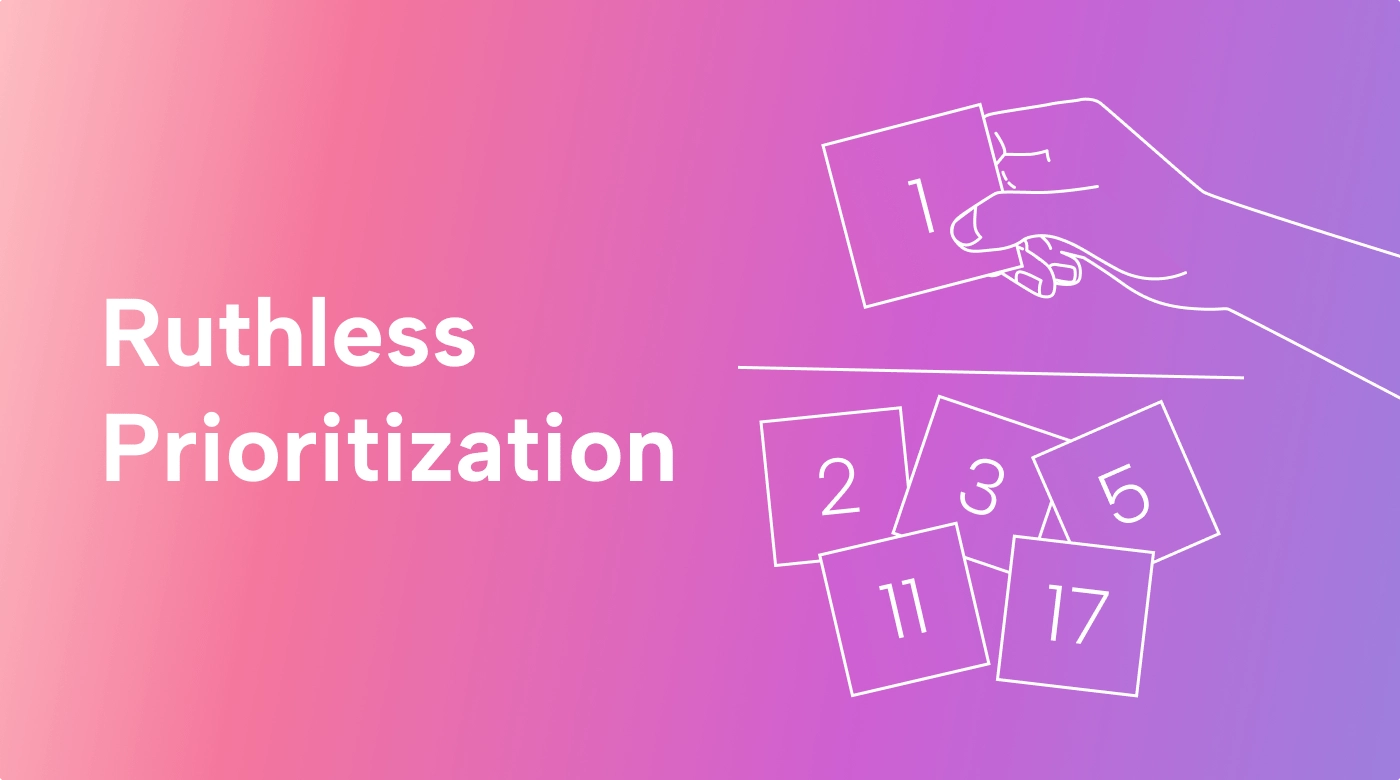In business, having the ability to focus on what truly matters can be the difference between failure and success. This is especially true in product management, where decisions on resource allocation and task prioritization directly impact a product's success in the market.
That’s where the strategic concept of ruthless prioritization comes in. It's about being uncompromising in focusing on what will drive the most significant results, even if that means delaying, altering, or dropping other initiatives.
In this article, we explain how ruthless prioritization works when it comes to both general tasks and product management.
What is ruthless prioritization?
Ruthless prioritization is a rigorous, disciplined method of evaluating and selecting tasks or projects within a given set of constraints. It is widely adopted in business in general and project management in particular since it helps business leaders and managers confidently make the tough choices needed to keep their company running at its best.
In ruthless prioritization, you focus on allocating resources — time, effort, and funds — to the most critical and impactful tasks or projects while deliberately eliminating less critical activities or putting them on the back burner.
Ruthless prioritization is especially useful in situations with resource constraints and tight deadlines. It’s also helpful for businesses focused on achieving fast growth, such as startups, as well as those in competitive industries.
What’s the difference between regular prioritization and ruthless prioritization?
Regular prioritization involves organizing tasks or projects based on their importance and urgency. The goal is to deal with as many as possible in a logical order.
Ruthless prioritization goes a step further. It not only organizes tasks and projects but also makes tough decisions to focus almost exclusively on those items with the highest impact or value. This is often done at the expense of sidelining or dropping less critical projects despite their potential benefits.
Ruthless prioritization is a calculated risk that trades a variety of “would like to have” activities for a laser-sharp focus on what matters most.
 |
Where does ruthless prioritization come from?
There’s no single inventor or specific moment in time when the concept of ruthless prioritization came about. Rather, it emerged from the natural evolution of management and productivity philosophies that emphasize efficiency and goal-oriented planning.
One of the contributing ideas, for instance, is the Pareto principle, or 80/20 rule, which suggests that, in general, roughly 80% of results stem from about 20% of efforts or causes. Companies can use this idea to identify which 20% of their efforts are most effective and allocate their best resources to those areas for optimal results.
Methodologies like Lean and Agile, which focus on maximizing outputs with minimal waste of time and effort, have also shaped this approach to prioritization.
Once the idea of ruthless prioritization emerged, it became widely used in product management for feature development. Startups embraced it to achieve rapid growth. You’ll also find it used where the key to success is focusing on the right things at the right times.
Key characteristics of ruthless prioritization
Though there’s no set methodology for practicing ruthless prioritization, the following characteristics and features show the principles that lie at its core:
A strong focus on value
Ruthless prioritization helps organizations and individuals identify and concentrate on projects and tasks that offer the highest value or return on investment (ROI) relative to the effort they put into them.
The net result of this strategic approach is that resources such as time, money, and manpower are allocated efficiently and not wasted on activities that contribute little to the business’s overarching goals.
An emphasis on speed and agility
By honing in on fewer essential priorities, teams can execute tasks faster and respond with more agility to outside factors such as shifting market trends and changes in technology.
This streamlined approach gives industries where speed to market is critical, such as app development, a significant competitive edge.
More clarity on goals and direction
One of the biggest advantages of ruthless prioritization is more clarity on goals and direction since it highlights which projects and tasks are most critical and should be addressed first or “right now.” This reduces potential confusion, decision fatigue, and the sense of paralysis that can come from facing too many choices at once.
 |
Better resource optimization
Ruthless prioritization is key to allocating finite resources to initiatives that are most likely to drive success, whether that success is measured by growth, profit, customer satisfaction, or other key performance indicators.
By focusing on these high-yield initiatives, companies can maximize the results of their efforts and stop squandering valuable resources on lower-yield projects and activities.
A need for decisive decision-making
Ruthless prioritization requires strong decision-making skills since it involves making tough choices — not just about selecting a smaller number of projects and tasks to focus on, but also about what not to do.
The task facing business leaders and managers here is to ensure that the priority choices they make are fully aligned with the company’s strategic direction. They also have to know that dropping other initiatives won’t damage the company’s image or ability to remain relevant in the marketplace.
Using ruthless prioritization for general operational efficiency
Whether in operations, marketing, HR, or R&D, ruthless prioritization helps teams across all organizational functions focus their often limited resources and time on what truly matters. This is particularly useful in project management, which usually involves working within set parameters (scope, time, and cost) to achieve specific goals.
In this context, ruthless prioritization is extremely helpful for keeping project teams focused on tasks that directly contribute to meeting the most important objectives. This is especially true when there are tight deadlines or budget constraints to contend with.
So, what does this look like on the ground? Let’s take a look at a scenario where ruthless prioritization can greatly improve general operations.
Prioritization scenario: An operational efficiency project
The following scenario shows how ruthless prioritization can streamline operations:
The project
Ed is the operations manager at a manufacturing plant. The company where he works is facing increasing pressure to reduce costs and improve efficiency without sacrificing product quality — and Ed is tasked with finding a workable, sustainable solution that will turn the current situation around.
 |
Identifying priorities
Ed starts by mapping out all operational areas where the company could make improvements, including supply chain logistics, production processes, and energy use. He gathers input from team leaders across departments to evaluate how potential changes could boost productivity or, on the other hand, cause disruptions and new resource limitations in existing processes.
This detailed upfront work helps Ed identify key areas that, if improved, could lead to greater efficiency and cost savings.
Evaluating the options
Using a simple cost-benefit analysis, Ed evaluates each project's expected ROI. His evaluation includes both direct costs and indirect benefits like improved employee satisfaction and environmental impact. He also considers strategic alignment by specifically focusing on projects that support the company's long-term goals of sustainability and innovation.
Making tough choices
Despite several promising projects on his list, Ed knows he must be ruthless in his prioritization and focus only on those with the highest potential impact.
Based on his research, Ed decides to prioritize two projects that he believes will have the greatest cost-reduction potential: (1) an upgrade to more energy-efficient machinery and (2) a redesign of the supply chain to reduce waste and improve production speed.
At the same time, to free up resources for his proposed projects, Ed recommends the following actions: (1) delaying non-essential upgrades to office facilities, (2) holding off on expanding the product line, and (3) scaling back routine maintenance overhauls until the machinery is fully upgraded.
Communicating and implementing
Ed presents his prioritization plan to the executive team. He highlights the expected benefits of his selected projects and shows how his proposed reductions in other projects that were on the docket will free up resources for his clear priorities.
With approval secured, he works closely with each department to implement the changes while remaining personally responsible for resource allocation and meeting critical timelines.
Adapting as needed
As the chosen projects progress, Ed stays flexible and adjusts various aspects of his selected priorities based on real-time results and feedback from the teams involved in the change process.
 |
Outcome
The initiatives Ed selected led to a significant reduction in the company’s energy costs and waste. They contributed to both greater operational efficiency and the company’s sustainability goals.
Because of Ed’s methodical and strategic prioritization approach, the workforce was able to execute these impactful projects without getting sidetracked by lesser priorities.
Using ruthless prioritization in product management
In product management, where the potential task list is almost always longer than the available resources, prioritization is not just a part of the job — it is the job. The goal here is to deliver maximum value to the customer while achieving business objectives within the restrictions of time, budget, and manpower.
In this setting, effective prioritization means making tough decisions that can define or redirect a product's trajectory and, ultimately, the company's fate in the marketplace.
Product managers must balance a complex set of factors, including customer needs, market trends, the pressures of competition, and internal resource and time constraints. They are responsible for a product's overall success and must make sure that every effort aligns with the company’s strategic vision and delivers high-quality products to customers.
Ruthless prioritization helps these managers focus on features and initiatives that can have the greatest impact on the product’s success.
Again, let’s look at how this would play out in a typical company.
Product management scenario: Launching a new product feature
Here’s a sample scenario for applying the principle of ruthless prioritization to product management:
The challenge
Emma, a product manager at a mid-sized tech company, is given the job of prioritizing features for the next release of the company’s project management software. The goal is to improve user satisfaction and engagement within the constraints of limited development resources and a tight timeline.
 |
Gathering data
Emma starts by gathering user feedback from surveys and interviews. She also analyzes usage data from the current software version. She notices a high demand for a new calendar integration feature, along with a large number of suggestions to improve the mobile app's user interface.
Initial prioritization
Emma chooses the RICE scoring model to evaluate potential improved product features, including calendar integration, user interface (UI) enhancements, and a few others suggested by the development team.
In this rigorous process, Emma scores each feature on Reach (how many users it will affect), Impact (the level of user satisfaction improvement), Confidence (how well the team estimated the scores), and Effort (the amount of it required to develop the feature).
Refining priorities
The calendar integration scores highest, promising significant user impact with reasonable effort. However, given the team's current capacity, Emma realizes they can't tackle both the integration and all the suggested UI enhancements at the same time.
Decision time
Emma decides that for the upcoming release, she will prioritize the calendar integration. She also selects the three most impactful UI improvements that can be implemented within these constraints. She presents her findings and rationale to the leadership team, using her research data to back up her proposal.
Execution and iteration
With approval secured and priorities set, the product team focuses on the calendar integration and the three selected UI enhancements.
Emma closely monitors the project execution, always ready to adjust elements of the approach based on development challenges or new user feedback.
Outcome
The new release is a success. The calendar feature, in particular, generates a significant increase in user engagement.
Because of Emma's strategic prioritization approach, the company’s resources were used efficiently and effectively. This disciplined approach delivered maximum value to users within the constraints of the project.
 |
How project management software can support ruthless prioritization
Ruthless prioritization is a powerful approach to selecting the best, most impactful, and strategically aligned projects — and eliminating projects that don’t deliver the same kinds of results.
Once they select prioritized projects, your teams will benefit from using advanced project management software such as Motion to keep their projects on track. The detailed analytics, real-time data, and visualization tools built into this project management software make it easier to see how well each project is progressing and save you valuable time in the process.
Interested? Try Motion for free for 7 days.












